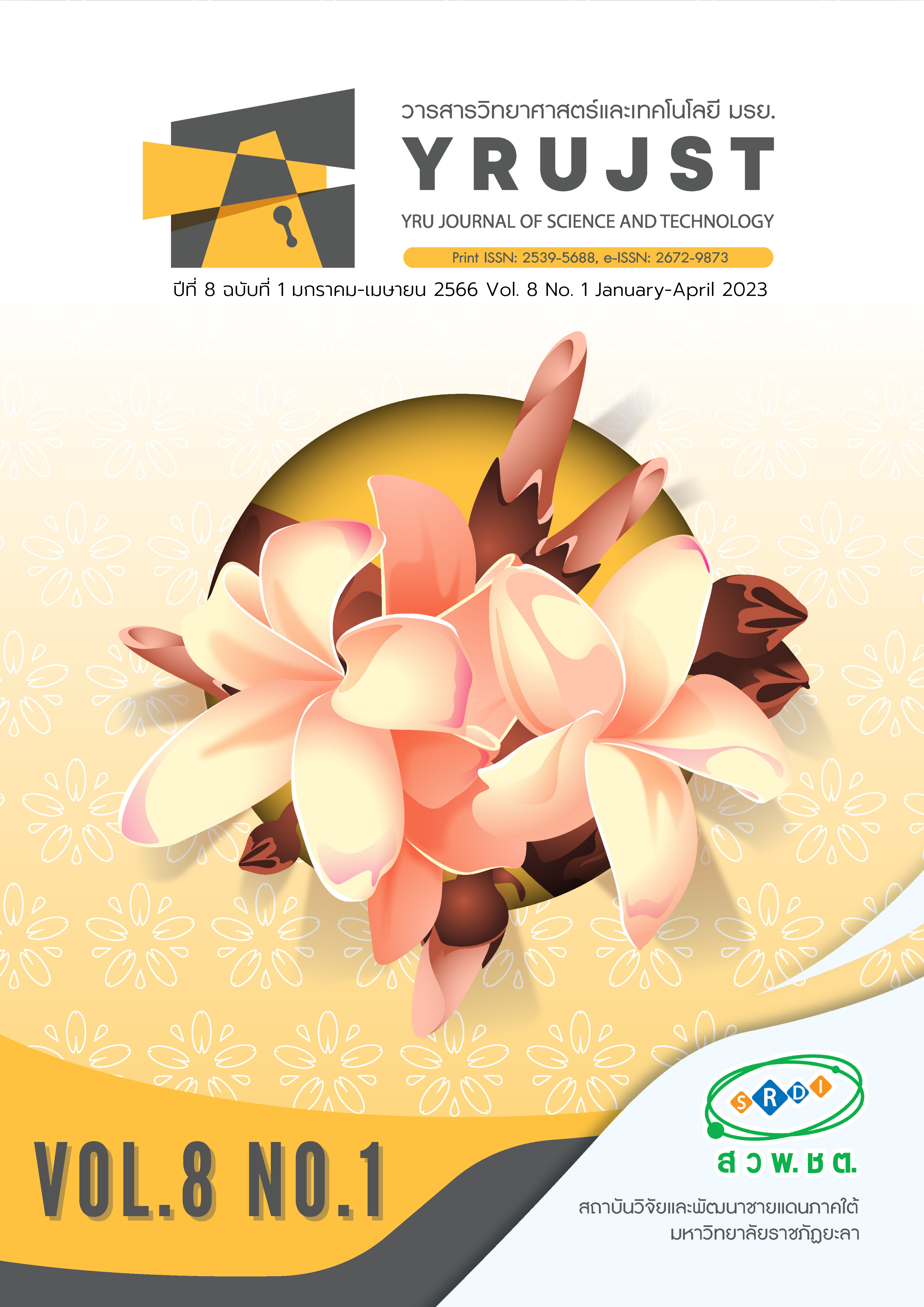Effect of Magnesium and Antagonistic Bacteria Bacillus subtilis SM1 on Controlling Rigidoporus microporus NK6 in Vitro
Main Article Content
Abstract
Nowadays, the exchangeable magnesium status, in rubber plantation areas in Southern Thailand, was mostly below the optimum range at 0.30 cmolc kg-1. Magnesium deficiency in soil has negative effects on plant growth process and sensitivity to plant disease infection by white root disease caused by Rigidoporus microporus. Biological control by using antagonistic bacteria such as Bacillus spp. has become an effective option for controlling plant disease. Therefore, this research aimed to study the effect of the antagonistic bacteria B. subtilis SM1 strain to prohibit R. microporus NK6 strain together with magnesium and its effect on growth of R. microporus.The result showed that, R. microporus NK6 strain was able to grow on potato dextrose agar (PDA) with magnesium but magnesium at concentrations of 0.3 and 0.5 cmolcL-1 occurred the change of mycelia morphology compared with no magnesium (control). B. subtilis SM1 strain was inhibited growth of R. microporus NK6 strain at 75.29% by dual culture test for the antagonistic evaluation. Consequently, using B. subtilis SM1 strain combined with magnesium at concentrations of 0.1 to 0.5 cmolcL-1 in PDA exhibited significantly reduced the growth of R. microporus NK6 strain compared with no magnesium (control).
Article Details

This work is licensed under a Creative Commons Attribution-NonCommercial-NoDerivatives 4.0 International License.
บทความ ข้อมูล เนื้อหา รูปภาพ ฯลฯ ที่ได้รับการเผยแพร่ในวารสารวิทยาศาสตร์และเทคโนโลยี มรย. นี้ ถือเป็นลิขสิทธิ์ของวารสารวิทยาศาสตร์และเทคโนโลยี มรย. หากบุคคลหรือหน่วยงานใดต้องการนำทั้งหมดหรือส่วนหนึ่งส่วนใดไปเผยแพร่ต่อหรือกระทำการใดๆ จะต้องได้รับอนุญาตเป็นลายลักษณ์อักษรจากวารสารวิทยาศาสตร์และเทคโนโลยี มรย. ก่อนเท่านั้น
References
Demishtein, K., Reifen, R. & Shemesh, M. (2019). Antimicrobial properties of magnesium open opportunities to develop healthier food. Nutrients, 11(10), 1-8.
Ieamkheng S. & Hoarong, M. (2014). Control of Rigidoporus lignosus causing of white root disease in rubber tree (Hevea brasiliensis Muell. Arg). Khon Kaen Agricultural Journal, 42(3), 686-692. (in Thai)
Jholapara, R. J., Mehta, R.S., Bhagwat, A. S., & Sawant, C. S. (2013). Exploring and optimizing the potential of chitinase production by isolated Bacillus spp. International Journal of Pharmacy and Pharmaceutical Sciences, 5(4), 412-418.
Kungpisdan, N., Rattanachoat, M., Permkrasin, P., Kiwrum, T., Chunamporn, L. & Thongphu, A.(2013). Development of Technology on Nutrition Management of Rubber, Rubber Research Institute. Bangkok: Department of Agriculture. (in Thai)
Morton, D. J. & Stroube, W. H. (1955). Antagonistic and stimulatory effects of soil microorganisms upon Sclerotium rolfsii. Phytopathol, 45(8), 417-420.
Najwa, M. J .A. (2013). Response of some fungal species to the effect of copper, magnesium and zinc under the laboratory condition. European Journal of Experimental Biology, 3(2), 535-540.
Nandris, D., Nicole, M. & Geiger, J. P. (1987). Root rot disease of rubber trees. Plant Disease, 71(4), 298-306.
Nisha, N.s., & Divakaran, J. (2014). Optimization of alkaline protease production from Bacillus subtilis NS isolated from sea water. African Journal of Biotechnology, 13(16), 1707-1713.
Nualkaew, H., Poonpakdee, C., Kaewmano, C. & Onthong, J. (2013). Fertilizer usage and soil management approach of rubber plantation in lowland and upland areas in Songkhla Province. Journal of Yala Rajabhat University, 8(2), 146-159. (in Thai)
Nur, S. T., Mohamed, M. H., Abu, S. I., & Siva, K. B. (2016). Determination and mapping of calcium and magnesium contents using geostatistical techniques in oil palm plantation related to basal stem rot disease. Songklanakarin Journal of Science and Technology, 38(1), 23-30.
Pholthaweechai, U. & Pengnoo, A. (2021). Effect of nitrogen and Bacillus subtilis SM1 strain on controlling Rigidoporus microporus NK6 strain the cause of white root rot disease In vitro testing. Songklanakarin Journal of Plant Science, 8(1), 44-49. (in Thai)
Rosenstock, N. P., Berner, C., Smits, M. M., Kram, P., & Wallander, H. (2016). The role of phosphorus, magnesium and potassium availability in soil fungal exploration of mineral nutrient sources in Norway spruce forests. New Phytologist, 554-567.
Skidmore, A. M. & Dickinson, C. H. (1976). Colony interaction and interference between Septoria nodorum and phylloplane fungi. Transactions of the British Mycological Society, 66, 57-64.
Sungtong, S., Pengnoo, A. & Boonyapipat, P. (2021). Efficacy of Bacillus spp. in controlling soilborne pathogen Rigidoporus microporus under control conditions. Songklanakarin Journal of Plant Science, 8(1), 34-43. (in Thai)
Wiler, R. M., Wilka, M. S. B., Jonas, A. R., Daniel D., Clistenes, W. A N., & Fabricio A. R. (2015). Magnesium-induced alterations in the photosynthetic performance and resistance of rice plants infected with Bipolaris oryzae. Scientia Agricolo, 72, 328-333.
Wiwattanapatapee, R., Chumthong, A., Pengnoo, A., & Kanjanamaneesathian, M. (2013). Preparation and evaluation of Bacillus megaterium-alginate microcapsules for control of rice sheath blight disease. World Journal of Microbiology and Biotechnology, 29, 1487-1497.
Zhang, D., Yu, S., Yang, Y., Zhang, J., Zhao, D., Pan, Y., et al. (2020). Antifungal effects of volatiles produced by Bacillus subtilis against Alternaria solani in potato. Frontiers in Microbiology, 11, 1-12.
Zhang, F., Du, P., Song, C. & Wu, Q. (2015). Alleviation of magnesium deficiency by mycorrhiza in trifoliate orange: Changes in physiological activity. Emirates Journal of Food and Agriculture, 27(10), 763-769.
Zho, J., Tan, T., Shen, A., Yang, X., Yu, Y., Gao, C., et al. (2020). Biocontrol potential of Bacillus subtilis IBFCBF-4 against Fusarium wilt of watermelon. Journal of Plant Pathology, 102, 433–441.
Zohora, U. S., Ano, T., & Rahman, M. S. (2016). Biocontrol of Rhizoctonia solani K1 by Iturin a producer Bacillus subtilis RB14 seed treatment in tomato plants. Advances in Microbiology, 6, 424-431.


